Old Skies review
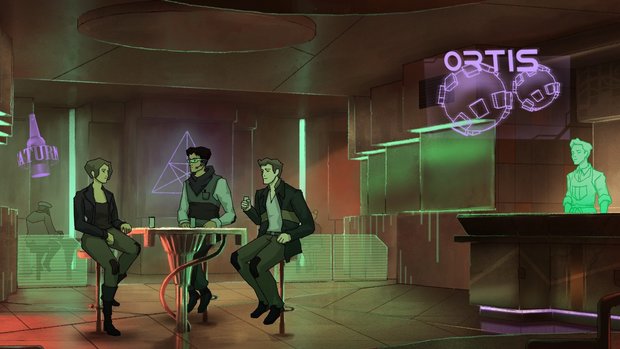
- 8 Comments
Dave Gilbert delivers what is sure to become a historic time-hopping adventure for the ages
We’ve all made choices we regret. Thoughts we never shared with those who’d listen, big scores we missed out on by folding one poker hand too early – whatever it is, it’s a universal feeling to lament what could have been if something had played out differently. Of course, there’s not much use mulling over what could have been, but… what if you had a chance to change all that, even if it means losing everything you know? If we existed in a world with the technology to travel through time, to gently nudge history ever so slightly in your favor – would you? In Old Skies, this is no mere hypothetical but the everyday reality: histories constantly shifting and rewriting themselves, timelines changing and memories altering to realign with the new “now.” Developer Dave Gilbert and his Wadjet Eye Games swan dive effortlessly into this complex setting and inject the world with some of the most memorable characters and jaw-dropping moments I have ever had the pleasure of experiencing in a point-and-click adventure.
Future me from the end of the review wants you to skip straight through to my highest recommendation, but that would be getting ahead of myself. It's the year 2062, and time travel is no longer science fiction. You are Fia Quinn, a time traveler with the ChronoZen international agency established to keep a modicum of control. Even with the attempted regulation of time travel, the technology to modify the “when” you call “now” is… well, unpredictable. The constant rewriting of history causes buildings to change shape and location, music and art to ebb in and out of existence, and family and friends to fluctuate between reality and oblivion. Thankfully, ChronoZen agents function outside the realm of traditional existence. Agents are selected through vigorous personality tests to see if they are up for the job – the world may change around them, but they remain as they are with all of their memories intact no matter how many times history is reshaped.
Fewer than a hundred agents exist within ChronoZen around the globe. But Fia isn’t alone in her job as a field agent. Her handler and knowledgeable guy-in-the-chair Frank Nozzarelli (known as “Nozzo”) and her fellow agent and mentor Duffy both keep Fia grounded while everything changes around them. Fia and Duffy are assigned to the New York branch of ChronoZen to handle field work with clients directly, while Nozzo stays behind in the current day to monitor them and provide guidance to each of them from the control center.
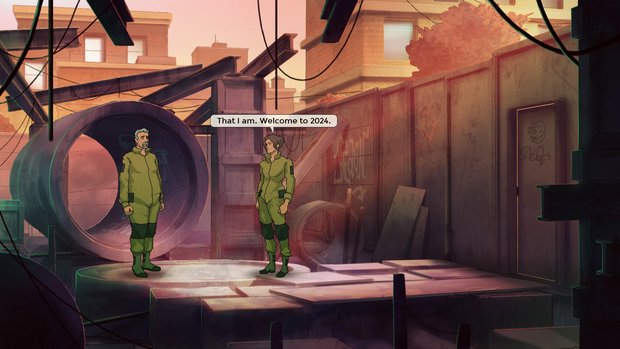
Like any company, however, ChronoZen is also a business in need of revenue, and people seek them out all over the world. Time travel isn’t cheap, and clients pay top dollar to travel back to previous periods for whatever purpose they require. On top of being expensive, there is a thorough psychological examination process that everyone must pass before the higher-ups at ChronoZen, referred to by agents as “the brass,” will let a client step foot into one of their facilities. History being rewritten by those with the money to throw at it – it’s not exactly subtle social commentary here.
Thankfully, even with the money and resources needed to commission ChronoZen for a time jump, there are rules and regulations in place to ensure history is tampered with responsibly. Through the use of vast computer algorithms, every person in history is given a timeline ranking – from Low, to Medium, to High. These rankings determine the importance of that individual remaining exactly as they are currently. If someone has a Low ranking, they could have their life altered beyond recognition and the brass wouldn’t bat an eye. But if someone has a High timeline ranking, any change to that person’s history would cause dramatic alterations to the world’s existence.
This is the world you find yourself in while playing Old Skies. As Fia, you are assigned to various clients to perform tasks with them at set points in history. These all take place within New York City, but there are countless possibilities of when. One client has you travel back to the 2040s, while another takes you much farther back to the end of the 19th century, to name just a couple time periods of many you’ll visit. You must accompany each client to ensure they comply with the rules and regulations, while also helping your client achieve their goal any way you can.
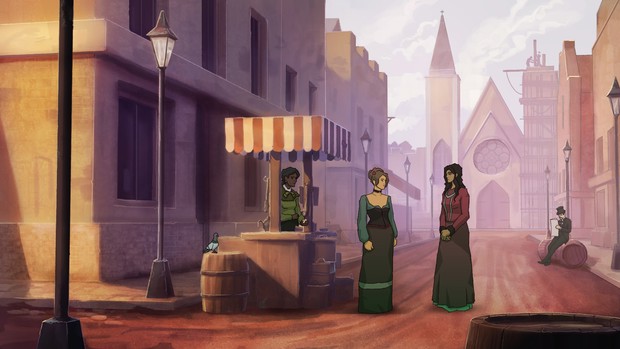
The game is split up into chapters, with each typically focusing on a single client and one moment in history. However, within them you may jump between multiple time periods close together (perhaps six months apart, or even just a few hours) to affect something in the past to change something else later. Client requests start out fairly simple – like visiting a favorite restaurant or asking someone a question when they were still alive – but this is time travel, and nothing is ever as simple as it may first seem. Every chapter introduces something unique using the time traveling gimmick. For example, at one point you have to maneuver around multiple Fias to avoid paradoxing yourself out of existence. You’ll need to think through some tricky time-bending conundrums to make it through this adventure in one piece.
Like in most traditional point-and-click adventure games, you’ll look around your environment and solve puzzles to progress the story. You’ll collect items here and there, but the vast majority of what you’re looking for here is information. Your inventory is hidden at the top of the screen during gameplay, and for the most part it’s standard stuff. But where Old Skies throws out the rulebook is with its ingenious search tool. As an agent of ChronoZen, you have access to a vast historical archive detailing information on every individual, organization, and event throughout all of human history. The catch? You need to know what to look for.
In each chapter, whenever you learn the name of a relevant person or some particularly important organization or event, a small pop-up will appear on the screen indicating a new search term is available in the database. Most individuals require finding out both first and last names separately – a character might say something about someone named “Jimmy,” but that alone isn’t going to do you much good. When someone else you question about him responds with something along the lines of “You mean Mr. Taylor?” – now you have “James Taylor” as a complete search term in the database, along with any information available on them in 2062. The integration of the archive with the minute-to-minute adventuring works seamlessly here. You discover the names you need naturally, making it feel like you’re right there with Fia revealing information in real time.
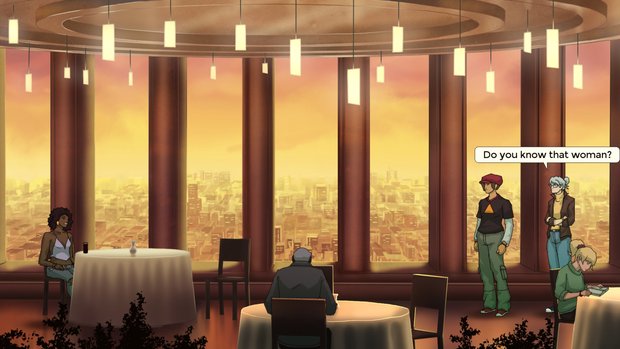
Your secret weapon with the archive is having access to information from the entire life of whoever you are looking up. If “James Taylor” has a dark secret that isn’t uncovered until his death, you’ll know about it years before anyone else in the past will. Or maybe “James Taylor” was once “James Smith?” Perhaps an alias used to avoid a life of crime, or worse? The search tool leads to some incredible outside-the-box puzzle solving where you have to think about who someone is at that current moment in history, as well as who that person will become long after you have left it behind.
While the majority of your time will be spent talking with characters and examining your surroundings to learn new terms for the archive, there’s plenty of standard pointing-and-clicking to perform over the fifteen-plus hours it will take to play through Old Skies. Everything is controlled exclusively through a single-click interface (although gamepad controls are supported). Highlighting your cursor over a person or place of interest in the environment will let you talk to or interact with them. Most things you hover over will have a descriptive text bubble pop up that will give Fia’s thoughts on it. Some objects can be picked up, although far fewer than in most traditional adventures. Early on, Fia calls Nozzo on her comms to jokingly ask if moving an old rag hanging from a sign will alter anything in history. While the answer is obviously “no” in this case, it makes sense that a time agent would want to tread lightly when messing with potential unintended butterfly effects.
Speaking of comms, next to the search tool on your inventory bar is a call button. Every ChronoZen agent is able to communicate directly with their handler through thoughts – or, “subvocalizing” as Nozzo calls it. This way, Fia can call Nozzo at any time during gameplay and receive guidance via pop-up hologram on how to proceed. Since the device is hands-free and doesn’t involve speaking out loud, you can call Nozzo even during sticky situations when you’re otherwise immobile.
In terms of in-game function, this acts as a hint feature that can help lead you to wherever you need to go next. But calling Nozzo a hint feature is a major disservice; while I like having the option of in-game assistance if I need it, there’s often a sense of gamey-ness to it that can easily take me out of the experience. Like with the search tool, however, Nozzo is part of the actual experience of playing Old Skies – Fia may be the star of the game, but Nozzo is an amazing character in his own right. You’ll call him up to have casual conversations, or ask his thoughts on the current situation you’re in and he’ll suggest where to check next based on the information he has available in 2062. I never felt like I was having my hand held with these interactions; it isn’t an exact “do this and then this” when you call him, just a general idea of what makes sense to try next.
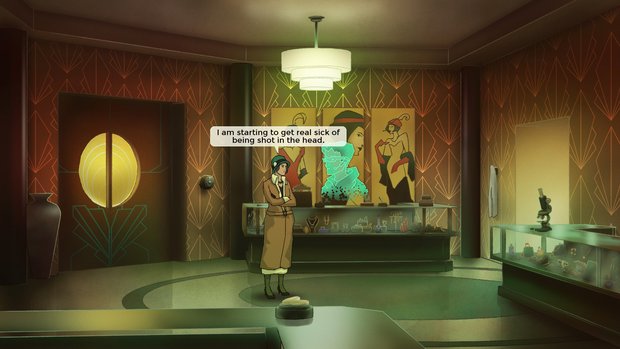
There’s one other major mechanic that makes this game unlike any other I’ve played: the death system. Since the dawn of time (or at least the late 80s/early 90s), the great debate in adventure games has raged regarding whether or not the player should be able to die. Both have their advantages and disadvantages – a deathless game allows for endless experimentation, while dying in a game sets up certain stakes that would be impossible to implement if a player knows no matter what they do they’ll be fine at the end of the day. But befitting a game about warping histories and expectations, Old Skies opens a door to a third option: What if experimentation through dying was required for progression?
Fia will die. A lot. Thankfully, you have Nozzo watching your back with access to technology of the future: the emergency rewind protocol. Both Fia and the client are outfitted with a Paradox Field Excluder, or PFE. This device shields the wearer from temporal paradoxes, and in the event of Fia’s untimely death, Nozzo can rewind time to essentially resurrect her (and the client too, if they also perish) to a short period of time before they died. As a ChronoZen agent, Fia remembers dying and will feel less-than-peachy wherever she was mortally wounded (you’d have a nasty headache too if you got brought back from a gunshot to the head), but she doesn’t lose any knowledge of what happened before that, which is crucial for succeeding the next time around.
Several puzzles revolve exclusively around Fia’s demise and learning new information each time that can only be gathered from dying in different ways. In one tense altercation, Fia will have to learn the combination for a safe – but you can only learn one number before inevitably getting killed. Fatal for the typical safecracker, but thankfully Fia will bounce back, if a little worse for wear, and keep on coming until you piece together the entire combination.
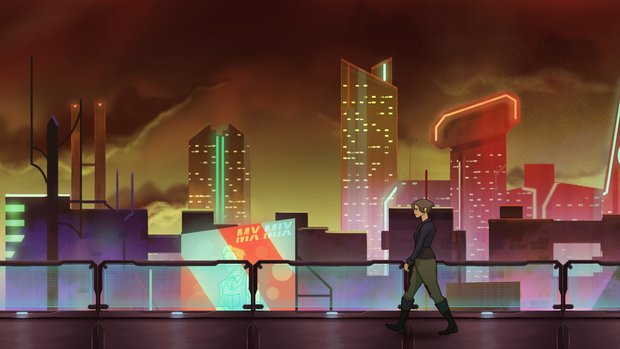
Another of my favorite early examples of this comes from a fight Fia has with a professional boxer, which presents a series of options to dodge left or right. Naturally, you will not get the correct sequence right away so you will inevitably get smashed in the face your first attempt (or first few attempts). But as you gradually learn the sequence of punches through trial and error, Fia also gets more lines of dialogue and sassy remarks to throw at her assailant. While these don’t impact the fight in any way, it makes for some fun additional dialogue to uncover in between hashing out the dodge sequence you need. Some of the lines had me falling out of my chair laughing, and one particular dumbstruck response from the boxer left me rolling. The same can be said when Fia gives a snide remark after getting shot in the head or mowed down by gunfire. Fia knowing how many times she has died leads to some absolutely brilliant moments of comedy. I never felt like I was being slapped on the wrist for making an incorrect choice, and every death led to more lines of incredibly well-written dialogue while keeping things moving forward.
Speaking of dialogue, the entire voice cast of Old Skies brings the characters wonderfully to life. Every character is immensely likeable, or at the very least incredibly compelling, but I would be remiss to not mention the standout performances of Sally Beaumont as Fia Quinn and Edwyn Tiong as Nozzo. Their delivery and the chemistry between their characters working as a team to solve time travel conundrums while jokingly giving each other grief is an absolute joy. At no point did I ever doubt these were two real agents of ChronoZen that had worked together for years. I laughed. I gasped. I cried. The number of emotions I felt while playing through this game ran the full spectrum of feelings, all of them genuine. This is a game where you travel to September 10th, 2001 in downtown New York City, with all of the weight that comes with it. And yet it’s never a bleak game – every moment is focused on the people living their lives at the moment you arrive, and the complexity of each character is handled with the same level of respect.
While I love silly time travel adventures like Day of the Tentacle, those stories tend to focus on one important historical figure or place per time period visited. Socrates for the Ancient Greece era, George Washington from the Revolutionary War period – et cetera. Old Skies focuses instead on the everyday people, and it is all the better for it. A struggling boxer desperately trying to provide for his family is so much more compelling to me than another story trying to find a new take on historical figures we have seen hundreds of times before. You’ll examine family heirlooms and photos, read documents and diaries that all go into the lives these characters live. Which hits all the harder when you realize that this is a world where one small nudge can change all of that.
In a departure from Wadjet Eye’s usual aesthetic, Old Skies is not presented in retro pixel art but a lovely hand-painted hi-res look. Everything here is polished to a razor sheen, befitting the retro-futuristic style of 2062. Low-resolution green text on a black background will pop up in a text box centered on the screen denoting the current date and time you arrive at whenever you emerge into a new era. Every time period you visit has the same impressive level of detail in their backgrounds and design, such as various textbooks and photos being strewn about a messy university apartment in the 2020s, or ropes and wires dangling off the sides of a long-defunct roller coaster on Coney Island in the early 90s. Whenever you return to Fia’s apartment in 2062, the view outside your window will differ: buildings will shift locations, sizes, or may no longer exist at all where they once did.
Old Skies is an even more beautiful game to look at in motion. Whenever you move between locations, Fia will be shown walking along a moving backdrop that changes depending on whatever time period you’re in. Little details like graffiti and ads on billboards help make every time period feel distinct. And whenever you time jump, there’s no question of how far in time you have moved. On a couple of occasions you move between two relatively short periods of time – months rather than decades – but even that changes the backgrounds dramatically. Characters are equally polished, with highly expressive models and rotoscoped animations for lifelike movements. Fia might crack a cheeky grin after teasing Nozzo over a sarcastic remark, or a character’s eyes might widen in surprise after Fia notes something only that person would know. There are a few gorgeous full-screen cutscenes during key story moments, where characters are zoomed in with full facial animations.
The art direction remarkably manages to stay consistent across all time periods and locations, which is incredibly impressive considering the vast array of eras you visit. The musical score is just as varied, with electronic music providing the backdrop of the hologram-filled halls of a futuristic bar in 2062, or swanky jazz saxophone while you run around the city’s shady underworld in the 1920s.
Final Verdict
While playing through Old Skies, I thought a lot about a quote I read from a 1998 review for Grim Fandango from an old PC Accelerator magazine: “A milestone for the graphic adventure, pushing the genre as far as possible without reinventing it.” Grim Fandango is my favorite adventure game ever made, and while only time will tell how Old Skies will fare on my own personal rankings as the years go on, it has already honed the point-and-click adventure beyond what I thought was possible. Every chapter, every character, every time period, and every moment exceeded my expectations. I could nitpick and say that some seemingly significant choices you make in-game prove to be largely inconsequential, but that’s the point – history is constantly being rewritten, and what would normally be a monumental decision ultimately ends up being something that can get undone the next day. It’s a game about living in the moment and appreciating what you have in the here and now, and in an ever-changing world we can all use a little of that. Like its subject matter, I find myself in a time loop of my own – the moment I saw the credits roll, I couldn’t wait to start playing Old Skies all over again.
Hot take
Old Skies takes the well-worn concept of time travel and shoots it back through history to make it fresh again. It’s a beautiful, wonderfully written and acted tale both epic and personal, with enough time-bending conundrums to keep even the most jaded adventure gamer guessing.
Pros
- Epic centuries-spanning story that feels both grandiose and deeply personal
- Superb cast of characters brought to life with phenomenal voice acting
- Stunning art direction and attention to detail in every era visited
- Ingenious puzzle design revolving around your death(s) and collecting information rather than relying on typical item-based brain teasers
- Beautiful musical score masterfully captures the feel of each historical period
Cons
- No way to rewind your own reality (yet) to play it again for the first time
Sam played Old Skies on PC using a review code provided by the game's publisher.


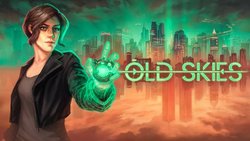


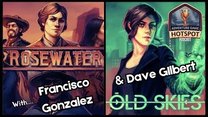





8 Comments
Want to join the discussion? Leave a comment as guest, sign in or register in our forums.
YES!!!
Reply
This is a wonderful review, I couldn’t agree more. This a GREAT game. From the story line, the puzzles to the voices to the art…… but I expect no less from Wadjet Eye Games.
Reply
I would like to post my review from Steam: Fantastic. A good adventure game should draw you immediately to its world. Make you want to experience it. Old Skies pulled me in. I found myself drawn from the first minutes and really struggled to put it down. Talking about specific points like graphics, puzzles etc', feels so unnecessary after such a great time with it. It really works as a whole. I am reminded of Arkham Asylum; a focused and tight experience with high production values. I'm sure there will be reviews that will go into all the small details and reviewers' small preferences. But for me, as somebody who grew up with adventure gamers, and finds it tricky to find ones that still have that charm and interest and naturality as the old classics had when we were young and not jaded... This one certainly has the charm. Highly recommended.
Reply
Hi, are all the cases connected in the end in a big arch plot or is it more like an episodic game?
Reply
Hi there! All of the individual chapters are connected via an overarching plot - each section tells a self-contained story but they all contribute to a larger narrative.
Reply
Ok, thanks!
Just finished this game. I have a lot to say about it, but that'll have to wait for another...time. For now, I just want to point out an error in the review. The reviewer mentions that learning the correct sequence in order to defeat the boxer is trial and error. It doesn't have to be. Minor puzzle spoiler ahead. If you go to the gym and watch him practice and listen to him call out his moves ("Left! Left! Right!") that is the sequence you need in order to dodge his punches and wear him out. It doesn't really make sense, since you tell Fia to dodge in the same direction as the punches he is calling out. It should be the opposite: If you dodge in the same direction, you'll get hit square in the face, of course. Still, one of the better puzzles in a game that's in dire need of decent puzzles. And someone with the decency to realize that it's not a good idea to make the player replay the same chapter three times from three different perspectives, in one of the most boring environments with some of the most boring and annoying characters in the game in the worst story arc of the game. Maybe one day I'll make a long comment sharing my thoughts about Old Skies, but the short of it is that it's a technically advanced adventure game (relative to most other 2d games in the genre), and it's game that sometimes does things very right and sometimes is quite poignant, tasteful, impactful and touching. But, more often than not, the opposite is true. A 6/10 at best for me. If you compare this to the best the genre has to offer, recently and in the so called 'Golden Age', there's no way it measures up as a 100%. What would Day of the Tentacle be? 500%?
Reply
Hi there! Thank you for reading the review and sharing your thoughts on the game. Regarding the solution for the boxer puzzle, I learned about this after completing the game and submitting my final review from others who beat the game once the game was released. I completely missed this on my playthrough, and thought it was pretty clever while clearly being easy to miss. I appreciate you pointing this out for folks - hoping this helps anyone playing the game going forward, as they'll have a much easier time getting through that section than I did!
Reply
Leave a comment